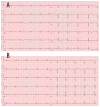Spontaneous Remission in a Case of Giant Cell Myocarditis with Preserved Left Ventricular Ejection Fraction
- PMID: 26581394
- PMCID: PMC4657619
- DOI: 10.12659/ajcr.895253
Spontaneous Remission in a Case of Giant Cell Myocarditis with Preserved Left Ventricular Ejection Fraction
Abstract
Background: Giant cell myocarditis (GCM) is rapidly progressive fulminant myocarditis causing death or requiring cardiac transplantation despite various immunosuppression therapies.
Case report: A 28-year-old woman with progressive shortness of breath and palpitation following an upper respiratory infection was referred to our institution. On admission, transthoracic echocardiography (TTE) revealed a preserved left ventricular ejection fraction (LVEF) with mildly impaired LV diastolic function despite extensive ECG abnormalities, a mildly elevated troponin I concentration, and moderately elevated N-terminal pro-brain natriuretic peptide (NT-pro-BNP) concentration. The diagnosis of GCM was made by endomyocardial biopsy (EMB), which revealed extensive fibrosis and inflammatory infiltration with multinucleated giant cells, as well as scattered eosinophils and lymphocytes in the absence of granuloma formation. However, the patient's symptoms began to improve without any specific therapy within 2 weeks, followed by the normalization of the ECG abnormalities, TTE-determined diastolic function, and troponin I and NT-pro-BNP concentrations. In sub-acute phase, 18F-fluorodeoxyglucose positron emission tomography showed no evidence of inflammation, and repeat EMB showed a significant decrease in the inflammatory infiltration and fibrosis, including absence of giant cells. Given the favorable clinical course, the patient was discharged without medications. At the 6-month follow-up, the patient had no LV functional impairment, cardiovascular events, or arrhythmia.
Conclusions: We encountered a rare case of atypical GCM in which clinical and histologic remission was achieved without immunosuppression therapy. There seems to be a population of GCM patients who improve without immunosuppression therapy. In monitoring GCM patients, clinicians should be aware of the possibility of spontaneous remission.
Figures



References
-
- Cooper LT, Jr, Berry GJ, Shabetai R. Idiopathic giant-cell myocarditis – natural history and treatment. Multicenter giant cell myocarditis study group investigators. N Engl J Med. 1997;336:1860–66. - PubMed
-
- Blauwet LA, Cooper LT. Idiopathic giant cell myocarditis and cardiac sarcoidosis. Heart Fail Rev. 2013;18:733–46. - PubMed
-
- Mahrholdt H, Goedecke C, Wagner A, et al. Cardiovascular magnetic resonance assessment of human myocarditis: A comparison to histology and molecular pathology. Circulation. 2004;109:1250–58. - PubMed
Publication types
MeSH terms
LinkOut - more resources
Full Text Sources
Research Materials

